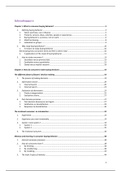Resume
Samenvatting Koopgedrag
- Établissement
- Universiteit Gent (UGent)
Samenvatting / notities vanuit de les (147 pagina's) + Professor workshops + Gastcolleges Kunnen engelse taalfouten instaan, mede doordat ik de prof vaak precies heb gequote. Exclusief Qualitative and Quantitative research workshop (Hierbij had ik niet veel bij genoteerd)
[Montrer plus]












